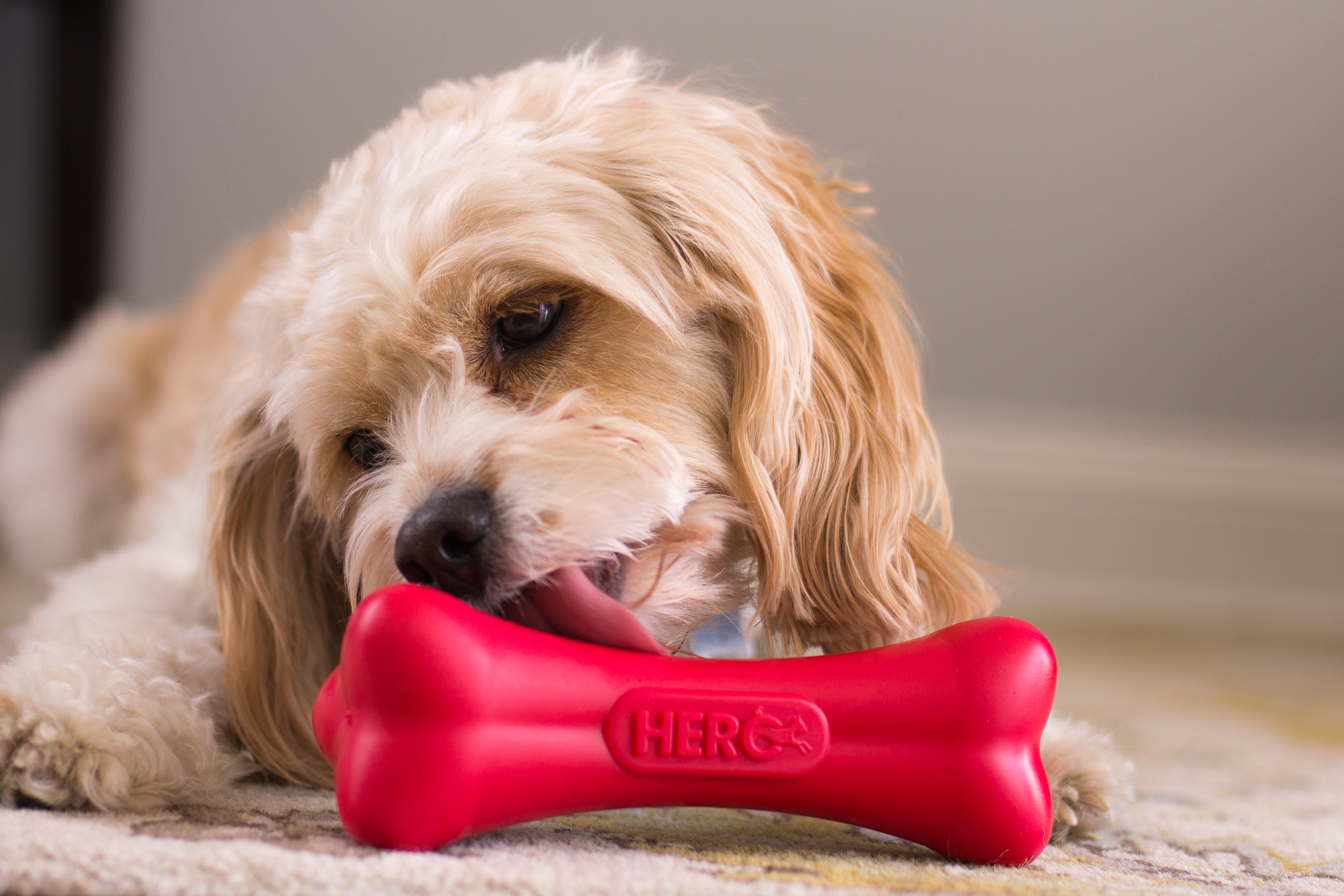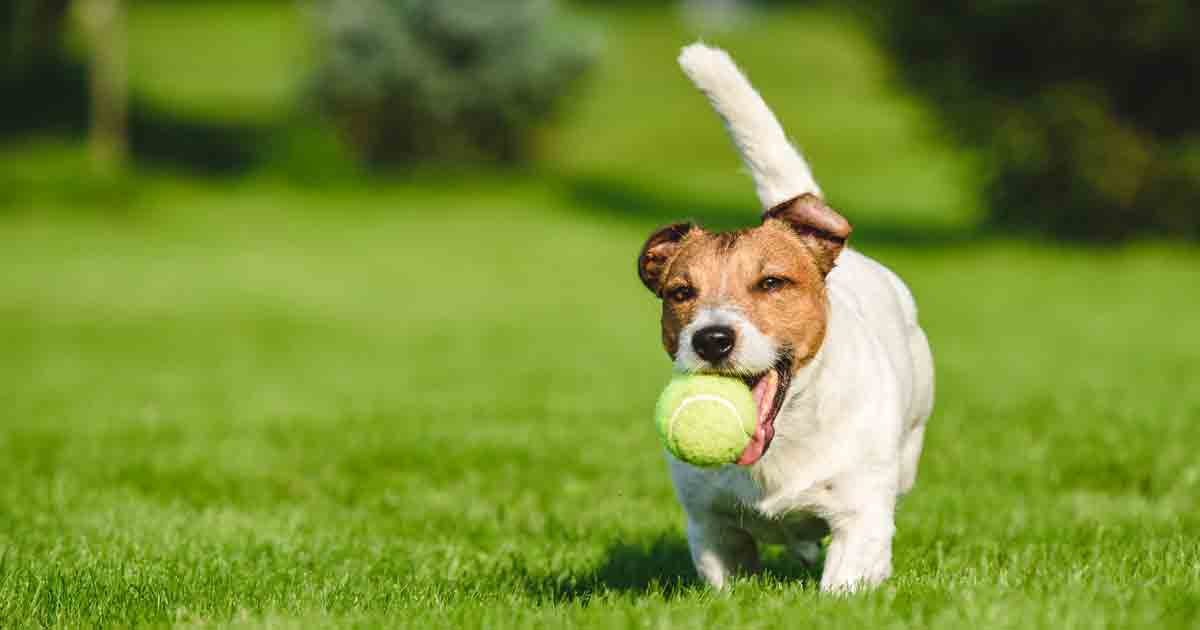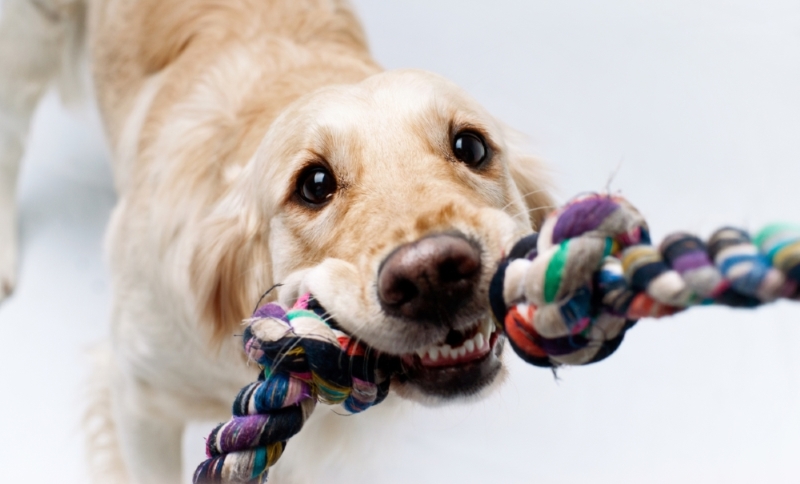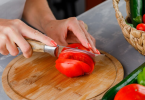
Choose Safe Dogs Toys For Your Small Dog
Choosing the appropriate dogs toys will make your small dog’s play time richer, while lessening his chance of accidental injury. Safe toys for your small dog can be purchased from pet supply stores or even made from household items, but it’s good to keep these few main safety concerns in mind.

Size Matters With Small Dog Toys
In general, small dogs toys should never be small enough to fit entirely in your dog’s mouth, or be capable of being broken into smaller pieces that can stick in his throat. A dog toy that’s too small can easily bounce back in your dog’s mouth and obstruct his windpipe, meaning he could suffocate to death if you aren’t in the immediate area to intervene! Sadly, this has happened to more than one dog. For that reason, small smooth balls just aren’t the best choice for most dogs.
ADVERTISEMENT

Tennis balls and the larger, hard rubber balls are big enough to stay out of the throats of most small dogs (make sure both kinds of balls are still whole and strong and not cracked). The small pull ropes found in pet aisles are also a good choice of toy for your small dog unless you find him attempting to eat the rope when you’re not busy playing. In that case, small fibers and threads from the rope can get stuck in his throat which again can be dangerous, especially if you’re not around to help.
ADVERTISEMENT

Very high-quality, unusual-shaped dogs toys like Kongs are also a good choice for small dogs. Even much larger dogs find it virtually impossible to chew Kongs into smaller pieces that can lodge in the throat and cause problems, not to mention Kongs can be made infinitely fascinating to your dog by stuffing them with dog treats, peanut butter or frozen beef broth.
ADVERTISEMENT

Ever thought of getting your small dog a pool? Most dogs love water, and will adore chasing their toys in and out of the pool. For small dogs, however, it’s terribly important to make sure they can easily clamber out, even when heavy and wet from the water. Make sure the sides of the pool are low and that your dog’s head easily clears the water. Avoid pools entirely for the toy dogs.
ADVERTISEMENT
Is your small dog a ripper, or does he play nicely with his toys? Dogs that are gentle can play relatively safely with a wide variety of toys, including small plush animals and squeaky toys. Other, more aggressive dogs need to be kept safe from toys with ribbons, “googly eyes,” or toys containing a squeaker, which can be chewed loose and pose a danger if swallowed.
ADVERTISEMENT

Materials Matter For Small Dogs Toys
No matter how carefully constructed, most dog toys are capable of splitting or crumbling at some point, and being ingested by your dog. This poses two problems. Most dog toy materials are naturally not meant to be eaten, and some can cause digestive trouble. Worse, if the piece in question is sharp, it can even puncture the dog internally. So it makes sense to select non-toxic small dog toys that don’t contain any brittle materials. The safest route is to stick to high quality latex and vinyl toys crafted specifically for use with dogs. The manufacturers of higher-end products, such as Kongs, have gone to great lengths to eliminate these kinds of risks.
No matter what small dogs toys you select for your pet, keeping these main safety points in mind should help you choose appropriate toys for your small dog that leave him happy and entertained and safe.
super chewer, dog toy box, best dog toys, good toys for dogs, barkbox toys, tough dog toys, kong puppy, shiba inu.
ADVERTISEMENT
Understanding Your Small Dog’s Needs
Small dogs, with their playful and curious nature, require toys that cater to their size, temperament, and chewing habits. Here’s a comprehensive guide to understanding their needs:
Identifying Suitable Toy Materials
Choosing toys made from durable, non-toxic materials is crucial. Opt for rubber, nylon, or natural materials like cotton and hemp to ensure safety during playtime. Avoid toys with small parts that could pose a choking hazard.
Consideration for Size and Texture
Small dogs may have delicate jaws, so selecting toys of appropriate size and texture is essential. Look for toys that are soft yet sturdy, providing stimulation without causing discomfort or injury.
Analyzing Chew Strength
Assess your dog’s chewing strength to determine suitable toys. Some small breeds have powerful jaws and may require reinforced toys, while others may prefer softer options.
Interactive vs. Solo Play
Evaluate whether your small dog enjoys interactive play or prefers solo toys. Interactive toys, such as puzzle feeders, provide mental stimulation, while solo toys offer independent entertainment.
Preference for Squeaky or Silent Toys
Observe your dog’s reaction to squeaky toys versus silent ones. While some dogs enjoy the auditory feedback, others may find it alarming. Choose toys that align with your dog’s preferences.
Considering Age and Developmental Stage
Take into account your dog’s age and developmental stage when selecting toys. Puppies may require softer toys to soothe teething discomfort, while adult dogs may prefer more challenging puzzles.
Rotation and Variety
Rotate your dog’s toys regularly to prevent boredom and encourage engagement. Introduce a variety of toys, including plushies, ropes, and balls, to cater to different play preferences.
Supervision and Safety Measures
Always supervise your dog during playtime, especially with new toys. Inspect toys regularly for signs of wear and tear, discarding damaged items to prevent choking or ingestion of foreign objects.
Environmental Considerations
Take into account your living environment when choosing toys. Indoor toys should be soft and lightweight to avoid damage to furniture, while outdoor toys should be sturdy and weather-resistant.
Integrating Training and Bonding
Use toys as a tool for training and bonding with your small dog. Incorporate obedience commands during play sessions to reinforce positive behavior and strengthen your relationship.
Choose Safe Dogs Toys For Your Small Dog: Now that you understand the essential factors to consider when choosing toys for your small dog, you can make informed decisions to keep them safe and entertained. Remember to prioritize safety, durability, and your dog’s preferences when selecting toys, ensuring a happy and healthy playtime experience.
FAQs (Frequently Asked Questions)
How do I know if a toy is safe for my small dog? To ensure safety, choose toys made from durable, non-toxic materials and avoid those with small parts that could be swallowed. Always supervise your dog during playtime and discard damaged toys promptly.
Are plush toys suitable for small dogs? Plush toys can be suitable for small dogs, but it’s essential to select sturdy options without small parts or squeakers that could pose a choking hazard. Monitor your dog’s play to ensure they don’t ingest any stuffing.
What types of toys are best for teething puppies? For teething puppies, soft and pliable toys made from rubber or nylon can provide relief from discomfort. Freeze toys or offer chilled carrots for added soothing benefits.
How often should I rotate my small dog’s toys? Rotate your small dog’s toys every few days to prevent boredom and encourage engagement. Introduce new toys periodically to keep playtime exciting.
Can small dogs play with larger dog toys? While some larger dog toys may be suitable for small breeds, it’s essential to choose toys of appropriate size and durability. Avoid toys that are too large or heavy, as they may pose a safety risk.
Should I allow my small dog to play with rope toys? Rope toys can be suitable for small dogs, but always supervise play to prevent ingestion of strings or frayed ends. Replace rope toys if they show signs of unraveling to avoid choking hazards.
Conclusion: Choosing safe toys for your small dog is a rewarding endeavor that enhances their well-being and strengthens your bond. By following the guidelines outlined here, you can create a stimulating and safe play environment for your furry friend, ensuring countless hours of joy and companionship.





I’m still learning from you, but I’m trying to reach my goals. I absolutely enjoy reading all that is posted on your blog.Keep the stories coming. I liked it!
Best view i have ever seen !